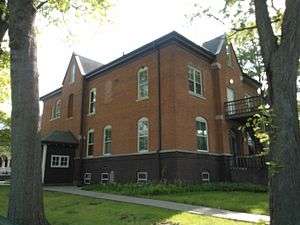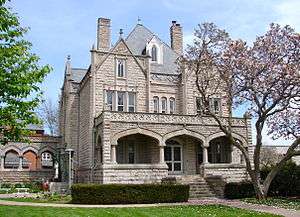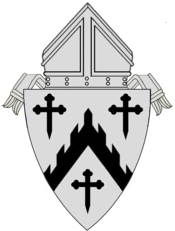Sacred Heart Cathedral (Davenport, Iowa)
| Sacred Heart Cathedral | |
|---|---|
|
| |
| Location | Davenport, Iowa |
| Country | United States |
| Denomination | Catholic Church |
| Website |
shcdavenport |
| History | |
| Founded | 1856 (parish) |
| Dedication | Sacred Heart of Jesus |
| Dedicated | November 15, 1891 |
| Architecture | |
| Status | Cathedral/Parish |
| Functional status | Active |
| Architect(s) | James J. Egan (Cathedral) |
| Style | Gothic Revival |
| Groundbreaking | June 1889 |
| Completed | 1891 |
| Specifications | |
| Length | 180 feet (55 m)[1] |
| Width | 80 feet (24 m) |
| Nave width | 65 feet (20 m) |
| Height | 75 feet (23 m) |
| Number of spires | One |
| Spire height | 160 feet (49 m) |
| Materials | Bedford stone |
| Administration | |
| Diocese | Davenport |
| Clergy | |
| Bishop(s) | Most Rev. Martin Amos |
| Rector | Rev. Richard Adam |
|
Sacred Heart Roman Catholic Cathedral Complex | |
  | |
| Location |
406 and 422 E. 10th St. and 419 E. 11th St. Davenport, Iowa |
| Coordinates | 41°31′49″N 90°34′8″W / 41.53028°N 90.56889°WCoordinates: 41°31′49″N 90°34′8″W / 41.53028°N 90.56889°W |
| Area | 2.35 acres (0.95 ha) |
| Architect |
Gustav Hanssen (Rectory) George P. Stauduhar (convent) |
| Architectural style | Late 19th and 20th Century Revivals, Tudor Gothic Revival |
| MPS | Davenport MRA |
| NRHP Reference # | 84001537[2] |
| Added to NRHP | April 5, 1984 |
Sacred Heart Cathedral, Davenport, Iowa, United States, is a Catholic cathedral and a parish church in the Diocese of Davenport. The cathedral is located on a bluff overlooking the Mississippi River to the east of Downtown Davenport. It is listed on the National Register of Historic Places as Sacred Heart Roman Catholic Cathedral Complex. This designation includes the church building, rectory and the former convent, which was torn down in 2012. The cathedral is adjacent to the Cork Hill Historic District, also on the National Register. Its location on Cork Hill, a section of the city settled by Irish immigrants, gives the cathedral its nickname Cork Hill Cathedral.
St. Margaret’s Cathedral

The parish traces its history back to 1856, when population growth in the city of Davenport led the Dubuque Diocese to decide to establish a new parish on top of the hill on the east side of Davenport. Antoine and Marguerite LeClaire donated the parcel of land and funds to build the church. Before this time parishioners attended St. Anthony's Church in downtown Davenport.
On June 29, 1856 Bishop Mathias Loras of Dubuque laid the cornerstone for the church.[3] Antoine LeClaire directed the construction of the church, which was named St. Margaret (or sometimes listed as St. Marguerite) in honor of St. Margaret of Scotland and Marguerite LeClaire. The church was built of red brick in the Romanesque Revival style. A frame rectory was built next to the church. It was moved to the back of the parish property in 1859 and a brick rectory replaced it. Once again Antoine LeClaire provided the money.[1] A year later a brick building was built on the west side of the church. It was meant to be a part of a future expansion of the church. The upper floor housed a Sodality Chapel and the main floor included a sacristy and school rooms for boys.
The Rev. Andrew Trevis was named the parish’s first pastor. In 1857 the Rev. Henry Cosgrove was assigned to St. Margaret’s after his ordination and became pastor in 1861. He was destined to spend the rest of his life associated with the parish.
During the American Civil War from 1861–1865 the Union Army established a headquarters in Davenport. There were five army camps in the city and four of them were within St. Margaret's parish boundaries. Undoubtedly, this affected the parish and the pastor's ministry.[4] After the war an addition was made to the church building in 1866 forming a wing on the right side of the original church structure. The 1860 building on the left side was also incorporated into the church. An unusual feature of the church was that the roofline of the addition was higher than that of the original church.[1]

An arsonist, who was never caught, set fire to the church on May 2, 1873. Damage was limited to the altar. A new altar was installed later that year with a painting of St. Margaret that still hangs in the present cathedral.[1] Another criminal act affected the parish in the early hours of the morning of March 31, 1878 when two gunman and a third individual attempted to rob the parish of a collection from the Forty Hours' Devotion the night before. One of the gunman shot at, but missed, Father Cosgrove who was still in bed. They escaped without the collection, but jewelry from the housekeeper's daughter. A $3,000 reward was offered and the three men were caught and sentenced to prison terms at the Anamosa State Penitentiary.[1]
On May 8, 1881 Pope Leo XIII established the Diocese of Davenport.[5] The Very Rev. John McMullen, the vicar general of the Archdiocese of Chicago and rector of Holy Name Cathedral, was chosen as the first bishop, and he made St. Margaret's his cathedral parish. Father Cosgrove became the cathedral’s rector and the vicar general of the diocese.
On July 11, 1884 Father Cosgrove was named by Pope Leo XIII to replace Bishop McMullen as Bishop of Davenport.[6] He was the first of three rectors to be named a bishop.
Sacred Heart Cathedral
A new cathedral
In 1889, Bishop Cosgrove decided that a new, larger church should be built. The parish was out-growing the old church and there was a desire for a structure with more of a cathedral image.[7] The church property sits in a residential area where the city's Irish community resided from the 1850s to 1900. Because a disproportionate number of people had their origins in County Cork the neighborhood became known as Cork Hill.
The initial planning for the new cathedral was carried out by Father Trevis, who was once again assigned to St Margaret's after Cosgrove was named bishop. The assignment became too much for him however, and he was replaced by the Rev. James Davis. James J. Egan, an architect from Chicago, was chosen to design the new cathedral. At the same time he also designed St. Ambrose Church in Des Moines, which became a cathedral in 1911.[8] The Ecclesiological Society, which had a mission of preserving Gothic architecture, was an influence in the church design. The cathedral was built on the English parish church model. Walsh & Edwards of Davenport were chosen to be the contractor, and Davenport architect Victor Huot as supervising architect.[1]
On April 27, 1890 the cornerstone for the new cathedral was laid. Gas pipe that was to be used for interior lighting was laid in February 1891. That same month lathing was applied and the walls and ceiling were plastered in April. The woodwork was completed by June. The frames for the windows were manufactured at a mill across the river in Rock Island, Illinois. The frame for the large window in the apse weighs 3½ tons.[9] The windows were donated by individuals and groups. The new cathedral was finished in 1891, and it was dedicated on November 15 of that year.
Name change
| A series of articles on the |
| Sacred Heart of Jesus |
|---|
 |
| Devotions |
| People |
| Encyclicals |
| Churches |
|
|
It was Father Trevis who suggested the parish's name change.[4] He had visited Paray-le-Monial in France where St. Margaret Mary Alacoque had the visions of the Sacred Heart. The devotion was also popular within St. Margaret's parish. Bishop Cosgrove also had a devotion to the Sacred Heart and had the image emblazoned on his coat of arms.[1] The bishop requested permission from Pope Leo XIII to name the new church Sacred Heart Cathedral. On December 23, 1889, the pope granted this permission on the grounds that a chapel dedicated to St. Margaret be maintained in the church. Sacred Heart Cathedral was the first cathedral to be dedicated to the Sacred Heart in the United States.[1]
Architecture

Sacred Heart follows a basilica plan with a corner tower. The foundation is composed of Anamosa Limestone and the walls of the structure are brick clad in rock-faced Bedford stone mined in Indiana. The nave is nine bays in length, and they are divided by buttresses. The first bay is the tower section. The other bays contain either a tracery or paired lancet window, which alternate down the nave. The church measures 180 feet (55 m) in length and its nave is 65 feet (20 m) wide.[1] Across the back, where the sacristy and St. Margaret's chapel are located, it is 80 feet (24 m) wide. The roof rises 75 feet (23 m) above the ground and the spire on top of the tower is 160 feet (49 m) tall. When it was completed the cathedral was the tallest structure in the Quad Cities.[10]
The church features an open interior without columns. There is an extensive amount of woodwork in the interior, including the altars, pews, ceiling, wainscoting, and the gallery frontal. There are four sets of oak pews across the width of the church. The reliefs below the old high altar depict the sacrifice of Able, Abraham and his son Isaac, and the priest Melchizedek. The statues of St. Peter and St. Paul were added later. Gold reliquaries that contain relics of various saints are in nooks on either side of the reredos. The shrine of the Blessed Virgin Mary on the left side of the church contains statues of St. Benedict on the left and St. Thomas Aquinas on the right that were added in 1902. At the base of the altar is a relief of the dormition of the Virgin. The St. Joseph shrine contains statues of St. Ignatius of Loyola on the left and St. Anthony of Padua on the right that were also added in 1902. At the base of the altar is a relief of Joseph on his death bed with Mary and Jesus at his side. Initially, the bishop's throne was placed in the archway on the left side of the sanctuary. The large stations of the cross are bas reliefs with wood frames that line the side walls of the church. They were installed in 1892.
The stained glass windows feature bright colors that were chose by Bishop Cosgrove.[1] The tall windows on the sides of the nave depict the Twelve Apostles. The rose window on the front of the church includes the following Christian images: an anchor for hope, wheat for bread, a crown for Christ the King, keys for the Apostle Peter, a dove for the Holy Spirit, the cross and crown for the crucifixion, the chalice and bread for the Holy Eucharist, and a harp for music and worship. The large window over the altar depicts Jesus appearing to St. Margaret Mary Alacoque, who spread the devotion to the Sacred Heart of Jesus.
Electric lights were installed in the sanctuary in 1895. A renovation of the cathedral's interior was completed in 1907. It included a frescoing of the interior, enlarging the choir loft, and adding six hundred new lights.[1]
20th Century
Bishop Cosgrove's health started to fail in the early 1900s and he requested a coadjutor bishop. Once again the cathedral's rector was chosen to be a bishop. Bishop Davis was the first bishop consecrated in Sacred Heart Cathedral on November 30, 1904.[11] He replaced Bishop Cosgrove upon the laters death two years later.
By the end of the first decade of the 20th century the parish's boundaries were set. In 1902 Our Lady of Lourdes was established in Gilbert, present day Bettendorf, and in 1909 St. Paul the Apostle was founded in Davenport. The parish's boundaries include some of the poorer sections of the central city as well as some of Davenport's older and wealthier neighborhoods. They also include six residential historic districts listed on the National Register of Historic Places: Bridge Avenue, Cork Hill, East 14th Street, the Village of East Davenport, Prospect Park, and McClellan Heights.
Lightning hit the building on August 20, 1928. The lightning sparked a fire between the slates of the roof and the ceiling. This caused extensive smoke and water damage to the church. Services were held in St. Margaret's Chapel during the repairs. The church was repainted in a gothic design. In order to hide the damage, the woodwork was stained a dark English Oak color. The ceiling decorations were completed by the Davenport decorating firm of Hartman and Sedding.
Starting in the 1960s the parish implemented a number of changes, which were in line with the reforms of the Second Vatican Council. In March 1964 a new altar was set up that allowed the priest to face the congregation. The cathedral was the first church in the Quad Cities to make this change.[9] The communion rail, pulpit and bishop's thrown were removed in 1980. A new cathedra, or bishop's chair, was placed against the reredos so that he would face the congregation. The liturgies were celebrated in English instead of Latin.
Social Ministry has been a hallmark of the cathedral parish since the pastorate of Msgr. Sebastian Menke. El Centro Cultural Hispano was founded in 1975 to serve the needs of Spanish-speaking people throughout the Quad City area. Masses in Spanish were celebrated at the cathedral starting in 1977.[12] The Latino community eventually relocated to St. Joseph's Church in Davenport. A clothing center that provides free clothes to those in need was established in the cathedral basement, and later a community food pantry was started by the parish. Sacred Heart was one of the founding churches of Quad Cities Interfaith. It also started Interfaith Housing, a non-profit corporation to rehab old and rundown houses in the inner city neighborhood.
Extensive renovations were done to the cathedral in the early 1990s. These renovations were made possible through the result of generosity of a member of the parish who included the parish in her will. This included replacing the roof and repainting the interior of the church. The painting of St. Margaret of Scotland that hung in St Margaret's Chapel was repaired and hung in the cathedral. The painting dates to 1873 and is the work of I. Schmitt. It was originally hung in the high altar of the old cathedral. The painting was severely damaged when it was removed from the old church. It was restored in 1990 at the Intermuseum Laboratory in Oberlin, Ohio.[9]
In recent years liturgies celebrated in Vietnamese were added to accommodate the areas growing Vietnamese Community. A shrine to Our Lady of La Vang was also added to the cathedral grounds in 2004.[9]
21st Century
On May 26, 2011 Pope Benedict XVI named Msgr. Robert Gruss as the Bishop of Rapid City.[13] He had served as the cathedral's rector and the parish pastor since 2010. He was the third rector/pastor to be named a bishop.
Rectory and Convent

The current rectory was designed by Davenport architect Gustav Hanssen and it was completed in 1895. The 2½-story house was built in the Tudor Gothic style. It was designed to complement the cathedral’s gothic revival style without copying it exactly. The exterior is composed of limestone. The structure is capped with a steep hipped roof and intersecting gables. The window openings are largely rectangular and some include tracery. There are also a few lancet windows. A porch and walkway with wide Tudor arches connects the rectory to the cathedral. At the time of the rectory's construction there was a friendly rivalry among the clergy as the bishop's residence at the time was not as large or modern.[7] An addition that included office space and garages was added to the east side of the rectory in the 1950s.
The convent was designed by Rock Island architect George P. Stauduhar.[14] It was composed of red brick to give variety to the cathedral complex.[7] The two-story structure was completed in 1902 and followed the gothic and Tudor styles of the church and rectory, although in a more simplified form. It was capped by a low hipped roof with gable pavilions. The convent featured pointed-arch windows in the pavilions and polygonal bay windows on the south side of the structure. The convent's location was centered behind the cathedral and the rectory. In 2012 it was torn down and a new side entrance with better access for the disabled was added to the east side of the church.[9]
Sacred Heart School

The parish school was established in 1859 in a frame building that was first used as the parish rectory.[3] This building was enlarged for more classroom space and living quarters for the Sisters of Charity of the Blessed Virgin Mary who began teaching in the school in 1861. In the school's early years there was usually a layman who taught the older boys in addition to the Sisters. Among them was M.V. Gannon who would go on to become an attorney of some merit.[1] A new brick school building was built between 1870–71.
In September 1882 Bishop McMullen established St. Ambrose Seminary and Academy, now known as St. Ambrose University, using two classrooms at St Margaret’s School. He assigned the Rev. A.J. Schulte, St. Margaret’s assistant pastor, as the school’s first president and instructor of the classics. St. Ambrose moved to its current location on Locust Street in 1885.
During Father Davis' pastorate a high school program for girls was begun and lasted for about ten years. Most of the girls spent a year or two in the program before they dropped out and went to work.[1] The first two girls who completed the four-year course graduated in 1902. The Rev. John Flannagan discontinued the high school program when he was pastor because of his ties with Immaculate Conception Academy
The present school building was constructed in 1914 for $104,093.44.[1] Bishop Davis dedicated the building on January 17, 1915. It was designed by Davenport architect Arthur Ebeling.[15] During the pastorate of Msgr. Marvin Mottet in the 1990s the parish school merged with St. Alphonsus School in the west end for several years and formed John Paul Academy. Both parishes then continued to sponsor their own schools until 2004 when it was no longer feasible to operate separate schools. Once again the parishes joined together and with Holy Family School in central Davenport to form All Saints School. The former Holy Family School building is used by the school.[16] Parish based religious education classes continue to be held in the Sacred Heart School building.
Pastors/Rectors

The following priests have served both St. Margaret's and Sacred Heart as its pastor. Since 1881 they have also served as cathedral rector:[9]
- Rev. Andrew Trevis (1856–1861)
- Rev. Henry Cosgrove (1861–1884)
- Rev. Andrew Trevis (1884–1889)
- Rev. James Davis (1889–1906)
- Rev. John Flannagan (1907–1926)
- Msgr. Francis Leonard (1926–1932)
- Msgr. William Shannahan (1932–1937)
- Msgr. Martin Cone (1937–1953)
- Msgr. Thomas Feeney (1953–1968)
- Msgr. Ralph Thompson (1968–1971)
- Msgr. Sebastian Menke (1973–1986)
- Msgr. Marvin Mottet (1986–2005)
- Rev. Robert Busher (2005–2010)
- Msgr. Robert Gruss (2010–2011)
- Rev. Richard Adam (2011–Present)
Pipe organ
The original pipe organ built in the cathedral had been moved from St. Margaret's Cathedral. It had been donated by Antoine LeClaire. It was replaced in September 1895 by a new instrument arraigned for by Father Davis at a cost of $3,000.[1] Therese Laurent, the cathedral's organist, and the cathedral choir gave a concert of sacred music to dedicate the new organ. Plans to replace that organ began as early as 1944. In 1949 the Kilgen Organ Company approached Msgr. Martin Cone about the possibility of installing an instrument that was intended for St. Rita's Church in Chicago. Construction on their new church had been delayed and so the organ, which was already being built, could be installed in Sacred Heart instead . The offer was accepted and the new pipe organ was installed for $27,000.[1] The Rev. James Greene from St. Ambrose Academy gave a dedicatory concert. The old Kilgen pipe organ was removed in 1991, and replaced with a new Noack pipe organ, opus 119.[17] It was first used for the Silver Jubilee of Bishop Gerald O'Keefe as bishop of Davenport on January 29, 1992.[9]
The organ is located in the rear gallery of the cathedral. Some of the pipes are exposed in three cases. It features a traditional style console with the mechanical action console detached from the main case.[18] It is equipped with slider chests, mechanical key action, and electric stop action. There are two manuals, 35 stops, 35 ranks, the manual compass is 61 notes, and the pedal compass is 32 notes. The drawknobs are in horizontal rows on terraced/stepped jambs. It features balanced swell shoes/pedals with standard AGO placement. The combination action is a computerized/digital system. AGO Standard (concave radiating) pedalboard, combination action thumb pistons, combination action toe studs.
Stoplist:[18]
GREAT ORGAN
|
SWELL ORGAN
|
PEDAL ORGAN
|
References
- 1 2 3 4 5 6 7 8 9 10 11 12 13 14 15 16 Greer, Edward (1956). Cork Hill Cathedral: The Chronicle of St. Margaret's and Sacred Heart Parish Davenport, Iowa 1856–1956. Davenport: Gordon.
- ↑ National Park Service (2010-07-09). "National Register Information System". National Register of Historic Places. National Park Service.
- 1 2 "Chapter XX:Churches and Parishes". Scott County Iowa USGenWeb Project. Retrieved 2010-03-01.
- 1 2 Schmidt, Madeleine M. (1981). Seasons of Growth: History of the Diocese of Davenport. Davenport, Iowa: Diocese of Davenport. p. 118.
- ↑ "Diocese of Davenport". New Advent. Retrieved 2010-03-01.
- ↑ "Bishop Henry Cosgrove". www.catholic-hierarchy.org. Retrieved 2010-06-01.
- 1 2 3 Martha Bowers, Marlys Svendsen-Roesler. "Sacred Heart Roman Catholic Cathedral Complex" (PDF). National Park Service. Retrieved 2014-11-20.
- ↑ "Historic Preservation in Davenport, Iowa" (PDF). City of Davenport. Retrieved 2010-05-20.
- 1 2 3 4 5 6 7 "Parish History". Sacred Heart Cathedral. Retrieved 2016-04-15.
- ↑ Bruce Walters (2011-09-08). "Art in Plain Sight: Two Davenport Cathedral Spires". River Cities' Reader. Retrieved 2012-10-13.
- ↑ "Bishop James J. Davis". www.catholic-hierarchy.org. Retrieved 2010-06-01.
- ↑ Schmidt, 293
- ↑ "Pope Names Bishop for Rapid City, South Dakota; Auxiliary Bishop for Milwaukee". United States Conference of Catholic Bishops. Retrieved 2011-05-26.
- ↑ "George P. Stauduhar" (PDF). University of Illinois. Retrieved 2012-04-26.
- ↑ The Ohio architect and builder, Volume 26. Google Books. Retrieved 2010-11-07.
- ↑ St. Alphonsus Parish, Davenport, Iowa: 100th Anniversary 1908–2008. Davenport, Iowa: St. Alphonsus Parish. 2008.
- ↑ "Our Instruments". Noack Organ Company. Retrieved 2010-02-12.
- 1 2 "Noack Organ Co., 1991, Opus 119". OHS Pipe Organ Database. Retrieved 2013-08-18.
External links
| Wikimedia Commons has media related to Sacred Heart Cathedral, Davenport, Iowa. |
